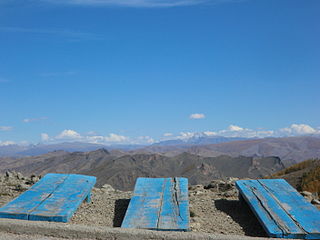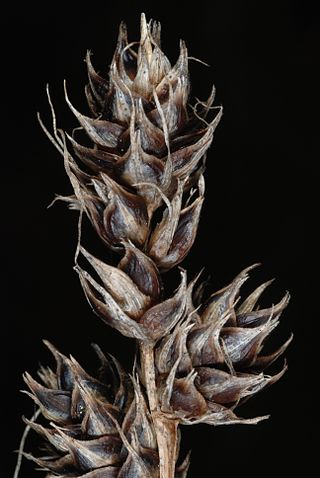Kenneth Kent Mackenzie (1877–1934) was a lawyer and amateur botanist who wrote extensively on the genus Carex in North America. The standard author abbreviation Mack. is used to indicate this person as the author when citing a botanical name.

Carex banksii is a species of flowering plant in the sedge family, Cyperaceae. Carex banksii is native to South America and was first formally named by Francis Boott in 1839.
Carex gunniana is an Australia species of sedge that was first described in 1845 by Boott in the Proceedings of the Linnean Society of London. It is native to eastern Australia and Tasmania.

Carex lanceolata is a species of sedge, native to the eastern half of China, Mongolia, eastern Siberia, Korea, Sakhalin, and Japan. Its seeds are dispersed by ants.

The Northeast Siberian taiga ecoregion is an area of "sparse taiga forest" between the Lena River and the Kolyma River in northeastern Siberia, Russia. The ecoregion's internal borders form a patchwork of territory constituting the southern part of the East Siberian Lowland, as well as lowlands around the East Siberian Mountains, including the ridges and peaks of the Verkhoyansk Range and the Chersky Range. On the southern border of the ecoregion is the north coast of the Sea of Okhotsk, giving the region maritime boreal forests as well as the continental forests situated inland. The ecoregion is one of the largest tracts of virgin boreal forest in the world, due to the very sparse population and difficult access. It is mostly in the Sakha Republic.

Tarvagatai Nuruu National Park covers the southwestern sector of the Tarvagatai Range of the Khangai Mountains in central Mongolia. The park is remote, protecting a transition zone between semi-arid steppe to the south and coniferous forests on the northern slope of the range. A large fire burned a significant part of the park in 2002, including 800 square kilometres (310 sq mi) of forest, mostly larch and siberian pine. The park is located about 60 km northeast of Uliastai, in the eastern region of Zavkhan Province.

Carex caryophyllea is a species of plant in the family Cyperaceae first described by Marc Antoine Louis Claret de La Tourrette. Two varieties are listed in the World Checklist of Selected Plant Families:
Carex aphyllopus is a species of sedge. Its native range is Central Japan.
Carex aematorhyncha is a species of flowering plant in the sedge family, Cyperaceae, native to South America. It was first formally named in 1854 in the sixth volume of Flora chilena.

Carex breviculmis, called the Asian shortstem sedge, is a species of flowering plant in the genus Carex, native to Asia from the Indian subcontinent to Southeast Asia, China, Taiwan, Korea, Japan, north as far as Khabarovsk Krai, and Malesia, New Guinea, Australia, Norfolk Island and New Zealand. It has been introduced to the US state of Mississippi. Typically found in forests, it is quite shade tolerant.

Carex tristachya, called the shiny-spike sedge, is a species of flowering plant in the genus Carex, native to south-central and southeast China, Korea, Japan, the Ryukyus, the Philippines, Borneo, and New Guinea. Its seeds are dispersed by ants.

Carex gaudichaudiana, also known as fen sedge, is a tussock-forming species of perennial sedge in the family Cyperaceae. It is native to parts of Australia and New Zealand.

Carex gravida, also known as heavy-fruited sedge, heavy sedge or long-awned bracted sedge, is a tussock-forming species of perennial sedge in the family Cyperaceae. It is native to southern parts of Canada and parts of the United States.
Carex interrupta is a tussock-forming species of perennial sedge in the family Cyperaceae. It is native to south eastern parts of Canada and north eastern parts of the United States.
Carex krausei, commonly known as Krause's sedge or carex de Krause in Canada, is a tussock-forming species of perennial sedge in the family Cyperaceae. It is native to subarctic areas of Greenland, Alaska, northern Canada and Russia.

Carex uruguensis is a tussock-forming species of perennial sedge in the family Cyperaceae. It is native to parts of South America.

Carex shimidzensis is a tussock-forming species of perennial sedge in the family Cyperaceae. It is native to parts of Japan, Korea and the Kuril Islands.

Carex secalina, the rye sedge, is a species of flowering plant in the family Cyperaceae. It is native to central and eastern Europe, the Caucasus, Iran, Kazakhstan, and on to Siberia, and it has been introduced to the Russian Far East, Belgium, and New York State. It is usually found growing in saline, wet meadows, and so is pre-adapted to grow in ditches next to roads that are heavily salted in winter.












